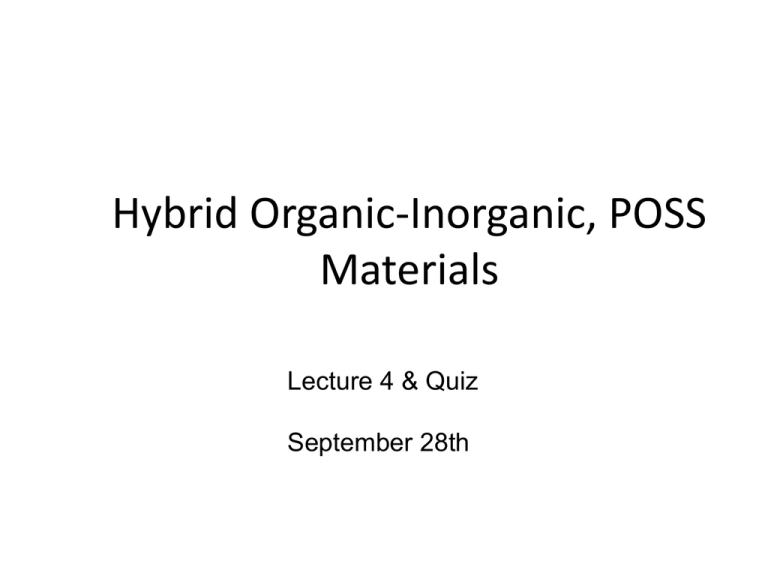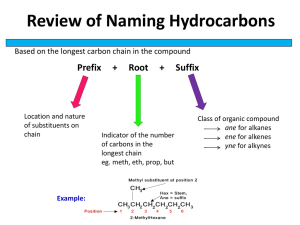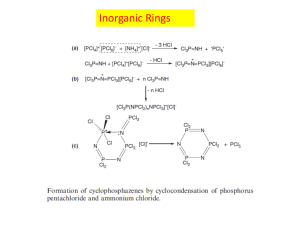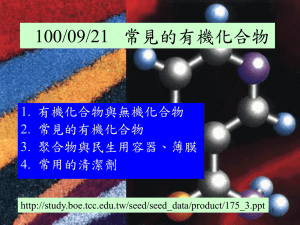Hybrid Organic-Inorganic Materials
advertisement

Hybrid Organic-Inorganic, POSS Materials Lecture 4 & Quiz September 28th Today First hour: • Some definitions • Strategies for making Hybrids Second hour: • Quiz • Discussion of quiz answers Course website • For lecture slides and other info. • Not at HIT website, at Loy research website:http://www.loyresearchgroup.com/ • Go to loy research group home page and select “courses” on menu at top. • Class website “Harbin Institute of Technology, Hybrid Materials Course” is the first entry. Direct url:http://www.loyresearchgroup.com/harbininstitute-technology---hybrid-materialscourse.html What are Hybrid Materials? Composite materials mixtures of organic and inorganic components Metal oxide network Improvement on either organic or inorganic components Introduction to polysilsesquioxanes R O R R R O Si OH Si OH Si HO O O O O O Si Si R Si O R R R Si O R O O O O Si OH R Si O Si O Si R R OH O Si O Si O R O R O Si R O OH Si Si O HO R R Si R SiO1.5 n n = 17 R R O Si O Si R OO O O R Si Si R Si O Si R O O O O Si O Si R R n=8 R SiO1.5 R8 Si8O12 Network of Si-O-Si Organic group (alkyl, aryl, alkenyl) attached through Si-C bond Fully condensed: 1.5 oxygens per Si Three siloxane bonds per silicon 8 Where are the organic and inorganic phases? R O R R R O Si OH Si OH Si HO O O O O O Si R Si O Si R R Si O R R O O O O Si OH R Si or O Si O Si R R OH O Si O Si O R R Si R O O OH O Si Si O HO R R Si H2O RSi(OMe)3 catalyst Blue is inorganic R R O Si O Si R OO O O R Si Si R Si O Si R O O O O Si O Si R R Black is organic •Segregation only at sub-molecular length scales. •Hybrid, synergistic properties come from very high surface area contact between phases Silsesquioxane Silicon 1.5 R SiO1.5 Oxygens n Polysilsesquioxane Many Many generally means more than 10,000 Dalto Oligosilsesquioxane A few Silicon 1.5 R SiO1.5 Oxygens n Oligo means > 1 and < 50-100 (depends on Mw or R group) R R O Si O Si R OO O O R Si Si R Si O Si R O O O O Si O Si R R n=8 R SiO1.5 R8 Si8O12 8 Nomenclature of silsesquioxanes • Polymers: poly(name of organic-silsesquioxane) eg. R = Ph or phenyl Ph SiO1.5 n poly(phenylsilsesquioxane) Nomenclature of silsesquioxanes • oligomers: oligo(name of organic-silsesquioxane) eg. R = Ph or phenyl Ph SiO1.5 n poly(oligosilsesquioxane) Nomenclature of silsesquioxanes • Polyhedral oligomers: need to describe size of rings eg. R = Ph or phenyl T8: n = 8 Ph Ph O Si O Si Ph OO O O Ph Si Si Ph Si O Si Ph O O O O Si O Si Ph Ph n=8 Ph SiO1.5 8 Ph8 Si8O12 Ph = phenyl IUPAC Name: 1,3,5,7,9,11,13,15-octaphenyl pentacyclo[9.5.1.13,9.15,15.17,13]octasiloxane Polyhedral refers to multi-sided geometric shapes like cubes. Drawing bridged polysilsesquioxane structures: Si CH2 O or H n + 3n H2O H Si(OMe)3 (MeO)3Si or (MeO)3Si -6 n MeOH O Si CH2 O CH2 O O (MeO)3Si CH2 Si(OMe)3 O Si O Si O O O Si Si O Si O Si O O CH2 CH2 CH2 O Si Si CH2 Si O Si O O O O O O Si O CH2 Si Si O O CH2 O O O Si O Si C H2 or Si(OMe)3 SiO1.5 O1.5Si Fully condensed: 1.5 oxygens per Si. or Si O Si O O n Methylene-bridged polysilsesquioxane n bridged polysilsesquioxane nomenclature: Si CH2 O O O Si O CH2 O O CH2 Si O O O Si O Si Si O Si O Si O O CH2 CH2 CH2 O Si Si CH2 O Si O Si O O O O O Si O CH2 Si Si O O CH2 O O O Si O Si C H2 or O1.5Si or SiO1.5 n Si O Si O O n Methylene-bridged polysilsesquioxane Not “methane-bridged” These are not silicas Not “methano-bridged” These are not silicates Not “methano-silica” Not “methylene modified silicate” Different ways to put hybrids together Class 1: No covalent bonds between inorganic and organic phases Example: particle filled polymer Class 2: Covalent bonds between inorganic and organic phases Monomers in solvent Gel or dry gel (xerogel) Close-up of hybrid particle In practice, how do you make these hybrids? Inorganic Organic Physical mixing Colloidal dispersion Aggregation or coalescence Like oil and water Class 1:Try to use high viscosity of polymer to hinder aggregation Class 2: Use covalent bonds to prevent aggregation of phases Making Hybrid Materials: Class 1A (pre-formed particles and fibers) R = Pre-formed Particles R Si O Si O R OO O Si O Si R R Si O Si R O OO O Si O Si R R or SiO2 or MOx or O1.5Si-R-SiO1.5 or R-SiO1.5 or Polymers Physical mixing of particles in melt or solution Easiest hybrid to make Inorganic Phases Metal Oxide Networks Organically modified Metal Oxide Networks Inorganic Phases Preformed inorganic clusters Ti(OR)4-x(acac)x Ti12O16(OPri)16 Silica Particles Ti18O22(OBun)26(Acac)2 POSS Ti17O24(OPri)20 Making silsesquioxanes as inorganic phase R O R R R O Si OH Si OH Si HO O O O O O Si R Si O Si R R Si O R R O O O O Si OH R Si or O Si O Si R R OH O Si O Si O R R Si R O O OH O Si Si O HO R R Si H2O RSi(OMe)3 catalyst Blue is inorganic Surface modified inorganic R R O Si O Si R OO O R Si O Si R Si O Si R O O O O Si O Si R R Black is organic Class 1A: POSS physically dispersed in polypropylene R OR' R Si OR' OR' R Si O Si R O OO O O Si R Si R Si O Si R = O O O O Si O Si R R POSS n R" Inorganic Phases Isolated metal atoms in polymeric architectures (organometallic polymers) While formally “inorganic” these behave more like organic Organic phases: Polymers Commercially available from Dow, BASF \ or from research chemical vendors: Aldrich or Polyscience Inorganic Phases Carbon Buckeyballs, nanotubes and graphene Organic need more than just carbon: CHNO Nature Materials 9, 868–871 (2010) Class 1: No covalent bonds between inorganic and organic phase (easiest hybrid to prepare) Example: particle filled polymer 1) First need to prepare or buy inorganic particles 2) then, depending on polymer melting point, mix into melt or solution of polymer 3) Cool (if melt) or evaporate solvent (if solution) If you were making this hybrid, what would you be worrying about? And how would you check experimentally? Making Hybrid Materials: Class 1B (in situ particle growth) OR' M(OR')x R'O Si OR' OR' No Solvent except for monomer(s) Generally uses low tg organic polymers or in polymer melts (< 100 °C). Viscous environment. Confined growth. OR' OR' R Si OR' R'O Si OR' R'O OR' R Si OR' OR' Making Hybrid Materials: Class 1B (in situ particle growth) "Inorganic monomer" CH3Si(OMe)3 Particles form in situ Polymerize inorganic monomer H2O LInear polymer 10-10000 nm Grow inorganic particles tin catalyst What must happen for this method to work? Melt Making Hybrid Materials: Class 1C (Polymerizing in pores) R R R R R R R R R R R R R R catalyst R R R R R R R R R R R R R •Porous metal oxide •Liquid monomer (no solvent) •UV, heat, radiation R R R R R R R R R R R R Non-porous composite material Same issues as in 1B, but organic polymerization must not be chemically hindered by metal oxide What polymerization chemistry is incompatible with silica or silsesquioxanes? Why? Making Hybrid Materials: Class 1D (encapsulation of small organics) HO HO OH O O catalyst HO O O H2O O O O HO O • Polymerize metal oxide around organic • pores must be small or leakage will occur •Solid state dye lasers, filters, colored glass Describe how the starting materials must behave for this to work O © AsahiKirin O Ancient Humans also made Hybrid organic-inorganic materials: Maya Blue Indigo + white clay palygorskite (Mg,Al)2Si4O10(OH)·4(H2O) (also called Fullers Earth) Class 1B or Class 1C or Class 1D?? L. A. Polette, N. Ugarte, M. José Yacamán and R. Chianelli, Sci. Am. Discovering Archaeology, 2000, July–August, 46 Making Hybrid Materials: Class 1E (Interpenetrating network) R R R R R R R R catalyst R R R R R R R R R R R R R R R R R R R R R R R R R R R • Both organic and inorganic phases grow simultaneously •Timing is more difficult • Reproducibility is a challenge • May need to use crosslinking organic monomers to ensure solid product R R R R R R What does this assume about the reaction kinetics? Making Hybrid Materials: Class 2A (Covalent links at molecular level) R R R R R R R R R R R R H2O R R R R R R R catalyst R R R R R R R R R • Organic group is attached to network at molecular level •Hypercrosslinking is possible •Pendant or bridging monomers •Bridging groups can be small or macromolecule •This class also includes the organometallic polymers R R R R R R Chromatographic Materials Photoresists for Lithography Low K Dielectrics Making Hybrid Materials: Class 2B (Covalent links at polymer level) R R R R R R R R R In Melt R R R R R R or in solution R R R R R • ligands attached to polymer • Reaction rates slow unless in sol. or melt R R R R R R R R R RR R R R R R R R R R R R R R R R R R R R R R Making Hybrid Materials: Class 2C Templating with block copolymers and surfactants excess water H+, OH- or F- Self-assembly surfactant into 3-D biphase system then polymerize in one of the phases (usually in the water phase) Making Hybrid Materials: Class 2C (Templating) Shown here with block copolymer A B O n hydrophobic polyisoprene m hydrophilic polethylene oxide Heat polymer then cool or cast from solvent Making Hybrid Materials: Class 2C (Templating) Shown here with block copolymer polyisoprene Block copolymer Sol-gel system PEO, Al2O3 and RSiO1.5 Block copolymer Multiple phases created by varying size of Templating with surfactants:(Class 2C) • First prepare two phase surfactant system • Add monomer. Solgel monomers move into aqueous phase with hydrolysis • Filter precipitate • remove surfactant by calcining or extraction Many different phases can be accessed 1. Davis, H. T., Bodet, J. F., Scriven, L. E., Miller, W. G. Physics of Amphiphilic Layers, 1987, Springer-Verlag, New York Surfactant templating to make hierarchical materials (Class 2C) Surfactant templating (Class 2C) Benzene-silica hybrid material with 3.8 nm pore diameter (Inagaki, Nature, 2002). Classes 2D Covalent coupling agents Attaching organic group onto inorganic material O O O Si(OEt)3 HO HO OH HO Si Si OH Si HO Si O O O OH Si O O OO O O O Si HO OH Si O Si O O Si O O Si O Si O HO Si O Si O O OO O O OH OO HO Si O Si Si O Si O Si OH Si OH O O Si O O O HO O O Si Si HO Si O Si O O HO OH OH HO OH OH OH Si O OHO Si O Si OH Si O O O O Si OH Si O O Si Si Si O OHO O Si O O O O Si OH HO O Si O Si Si O O Si O O O HO Si O O Si O O Si OH Si O Si O O Si HO OH HO HO O Si O OH O Si HO O Si OO HO Si O O Si HO OHO O O O OH O O O Classes 2E Covalent coupling agentsAttaching inorganic group onto organic polymer h polyethylene Si(OEt)3 Si(OEt)3 For tough electrical wire coating & shrink fit wrap Summary • Silsesquioxane nomenclature is hard to pronounce • Organosilica is improper nomenclature • Mixing polymer with anything is hard & may not work • Good mixing is necessary for hybrids • Surfactants can template hierarchical structures







